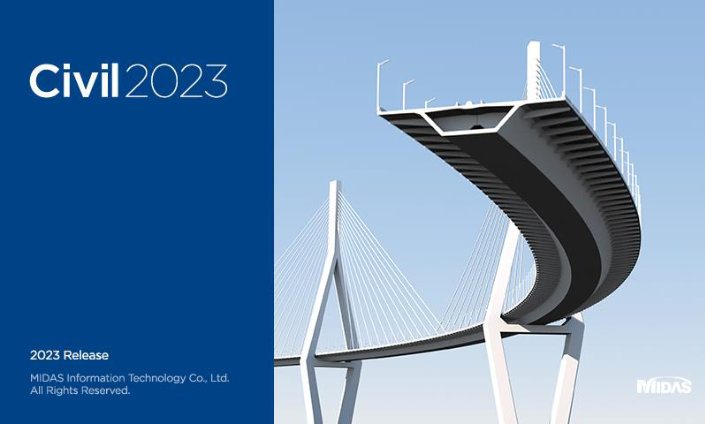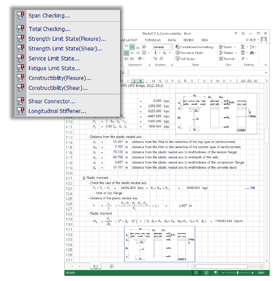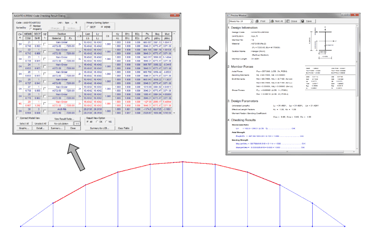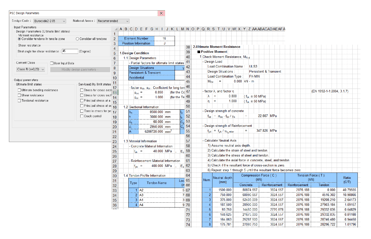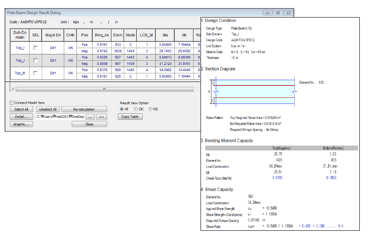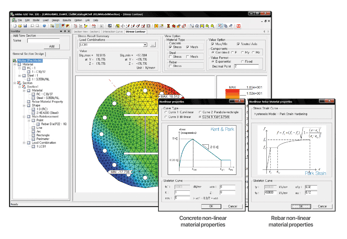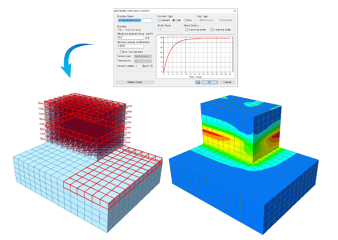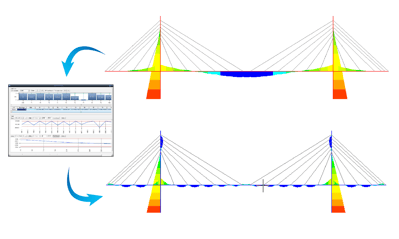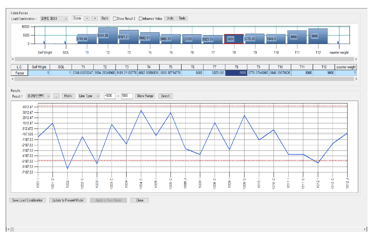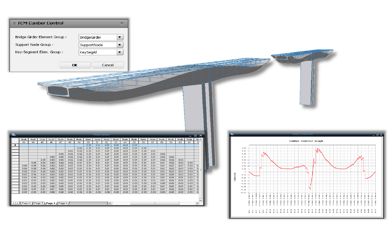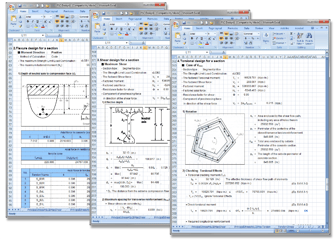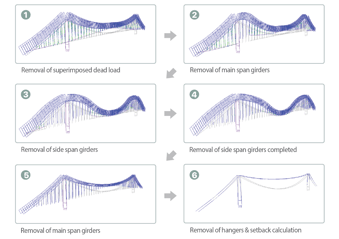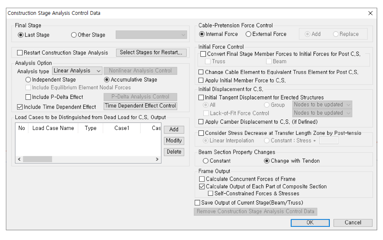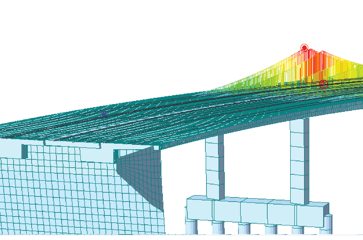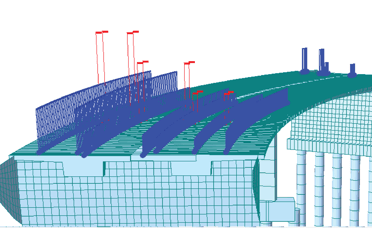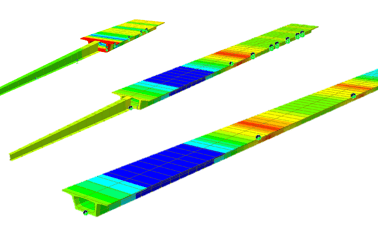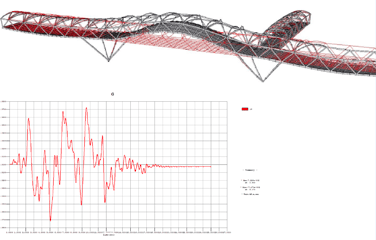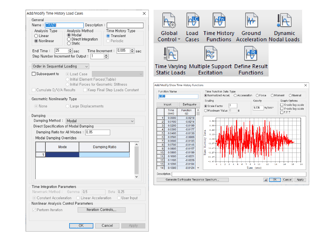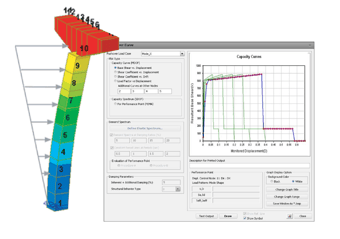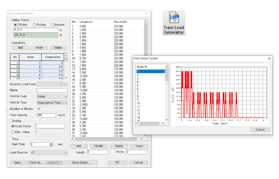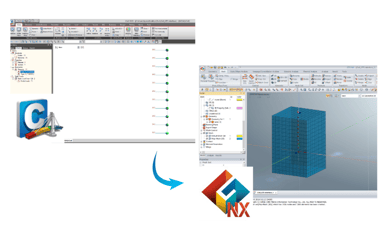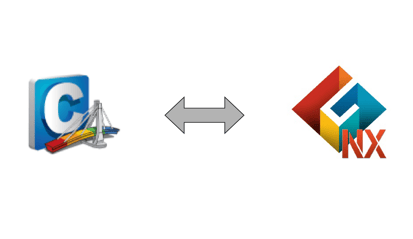midas Civil 2023 v1.2 cracked license
$ 140.00
Release Date : July. 06, 2023
midas Civil is one of the top 5 Bridge Design & Analysis Software that combines the ease of modeling with exclusive analysis features, making modeling and designing efficient for engineers. The engineering software provides handy features for simpler bridges and flexibility to deal with complex geometry – combining all important features of bridge analysis software and bridge design software.
It includes various design codes that become very useful for engineers looking for optimized designs. midas Civil will lighten your work and make bridge design more accessible through our bridge design software. So, let’s explore what your best partner can do for you.
Description
Enhancements in Civil 2023 (v1.2)
1. Improvement of Design Speed for Eurocode
2. Remove the requirement of clause 9.5.2 in EC2
3. Bug fixes found in Civil 2023 (v1.1)
Enhancements in Civil 2023 (v1.1): Refer to Civil 2023 (v1.1) release note for details.
1. Moving Load Analysis to French Former Standard: FASCICULE N° 61 TITRE II
2. French National Annex to Eurocode 2, 3, 4
3. Eurocode Design Report in French
4. Eurocode Design Report in Word Format
5. Preference Setting for Design Report Language
6. Time Dependent Material: Modulus of Elasticity Suggested by Gilbert and Ranzi
7. PSC Design: User Input of Torsion Parameters, Ak and uk
8. Equivalent Beam Stress Results for Construction Stage Analysis
9. GSD Excel Report: Print Results of All Load Combinations
10. Concrete & Rebar Material Database to South Africa: TMH7
11. Concurrent Disp./Vel./Accel. for Time History Analysis
12. Transmission Zone Design of Pretensioned Beam to AASHTO LRFD
13. SNiP/SP PSC Design: Crack Opening Coefficient by Tendon Material
14. Concurrent Joint Forces
15. Improvement in Auto Load combinations as per IRC 6
16. Improvement in PSC design parameters as per IRC 112:2020
17. Improvement in PSC & RC design as per IRC 112:2020
18. Other Enhancements
Quick Access
User-Friendly GUI
Graphical User Interface can be directly linked with an engineer’s flexibility to perform modeling and make changes to that. The GUI of midas Civil is designed so a user feels full liberty and ease while performing bridge modeling. The user-oriented input/output functions offer excellent facilities and productivity for the modeling and analysis of various bridge structures ranging from simple to complex ones.
Minimized Workloads
Intuitive Modeling
midas Civil provides the user with unlimited and efficient modeling methods for any project. manual modeling? Wizard? Data exchange? Everything can be found in midas Civil. They create nodes and elements, like CAD programs, as a conventional modeling approach. Bridge-oriented features like Bridge Wizards are favorites of bridge engineers. The Bridge Wizards can create a complete bridge model for you in a blink of an eye, and one can make any modification to the model, hence providing full liberty to the engineer. Other efficient approaches are also available, such as CAD import, table format modeling, and code format modeling.
Easy Analysis
Complete Analysis Options
No additional programs are needed. As one of the best structural analysis and design software, midas Civil performs all the essential analyses required for primary bridges, like moving Load Analysis, Construction Stage Analysis, Eigen Value analysis, and Linear and Non-Linear Analysis. But when the need arises for high-end analysis for complex bridges like Buckling Analysis, Cable Force Tuning, Rail Structure Interaction, and Settlement Analysis, that can also be easily performed in the software. Therefore, providing a stable platform to bridge engineers for their daily use to their high-end use.
Result Interpretation Done Right
Powerful Post Processor
The post-processor can automatically create load combinations by specified design standards. Changing the type of display can produce various forms of graphic output. The results can be practically animated, like node shapes, time history, and static analysis results. midas Civil also provides results that are compatible with MS Excel, which enables result extraction easily, and the user can review all analysis and design results systematically.
Optimized Designs
Auto Design and Load Rating
As a top structural engineering software, midas Civil has inbuilt design code checking and load rating features. AASHTO LRFD & LRFR, CHBDC CSA, EUROCODE, and other codes are available. The codes are constantly updated to ensure the users can best take advantage of the code-checking and rating features in the program. The automatic report generation features give the users an organized and detailed report that includes formulas and code references, which gives users confidence in their results and becomes their best partner in bridge design.
Steel Bridges
Overview
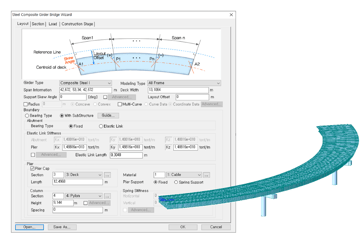
Modeling
+ Structure wizards (Steel composite, ILM, Truss, and etc.)
+ Link & Release/Offset type boundaries
+ Sectional property calculator
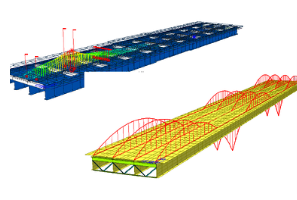
Analysis
+ Moving load analysis
+ Buckling analysis
+ Effective width scale factor
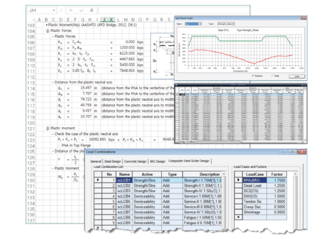
Design
+ Steel design
+ Composite design
In midas Civil, the user can consider various design sections of a structure by using the database of the section property of the steel bridge and the Sectional Property Calculator function. Steel bridges have many connections between members. These properties can be considered using midas Civil’s links & release/offset boundaries. After modeling the bridge, structural analysis such as static analysis, buckling analysis, moving load analysis, etc., can be performed using midas Civil. Thereafter, the user can review the appropriateness of the section by using the steel design and composite design functions.
Details
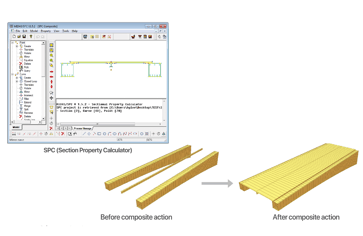
Sectional Property Calculator
User-defined sections can be created using the Sectional Property Calculator (SPC). *.dxf files can be directly imported, making it easy to create sections. The section property calculations are provided for the input section configuration by generating fully automated optimum meshes. Furthermore, it is possible to create composite sections composed of several materials.
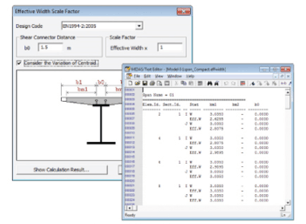
Effective Width Scale Factor
A scale factor for a moment of inertia (Iyy) about y-axis can be applied to check sectional stresses reflecting an effective width. Scale factors for the distances from the neutral axis to the top and bottom extreme fibers (z_top & z-bot) are also specified. The scale factors are applied only to stress calculations and do not affect the calculations for forces and deflections. For steel composite sections and prestressed concrete sections, additional options that calculate the effective width are provided.
Composite Design
midas Civil provides two types of design check in Composite Design (Composite Steel Plate Girder Design & Composite General Section Design). By inputting the design variables, longitudinal & transverse stiffeners information, and shear connector information into the Composite Design function, the design can be reviewed for the entire model or for selected sections. The design results can be checked in the detailed report, table, and graphical views.
Arch Bridges
Overview
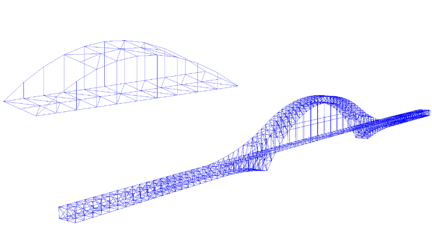
Modeling
+ Various elements (Truss, Beam,
Plate, Cable and etc.)
+ Tapered group
+ Sectional property calculator
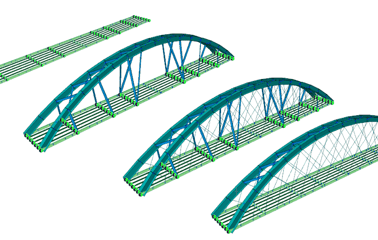
Analysis
+ Construction stage analysis
+ Buckling analysis
+ Moving load analysis
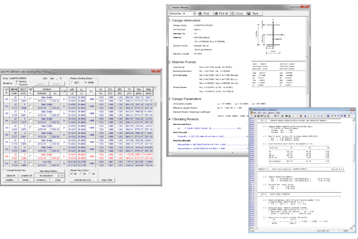
Design
+ Unknown load factor
+ Cable force tuning
+ Steel design
Arch bridges can be easily modeled by using various element types, unlimited section generation functions, various boundary conditions, and load input functions. After the modeling of the bridge is completed, the user can perform construction stage analysis, moving load analysis, and static analysis. Nonlinear analysis can also be performed for a more detailed review of the analytical model. After completing the analysis, sections can be reviewed with the Steel design function. For cable arch bridges, the user can easily adjust the tensioning force of the cable by using the unknown load factor and the cable force tuning functions.
Details
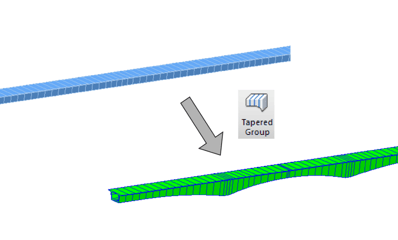
Tapered Group
The Tapered Group function makes it possible to create tapered sections more quickly. This function is also provided to solve the inconvenience of creating multiple tapered section properties when tapered sections are applied to multiple elements. By using the tapered group function, the user can implement cross-sectional changes in multiple elements linearly or polynomially. This function is available for all structures with varying sections including balanced cantilever bridges, arch ribs with tapered sections, etc.
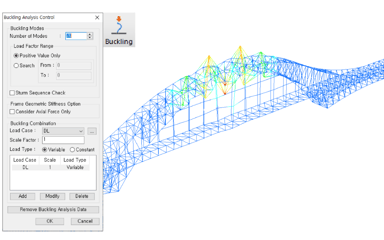
Buckling Analysis Control
This function is used for buckling analysis in midas Civil. After a simple setup, the program proceeds with the buckling analysis using the geometric stiffness matrix and the stiffness matrix of the structure. The geometric stiffness matrix is calculated from the static load analysis results selected by the user.
Steel Design
The Steel Design function verifies the strength of overall steel members reflecting live load reduction factors, correction factors for seismic loads, and moving loads. It also reanalyzes and reevaluates the strength of selected members due to varying design properties and criteria. It provides an optimal section design feature.
Precast Concrete Bridg
Overview
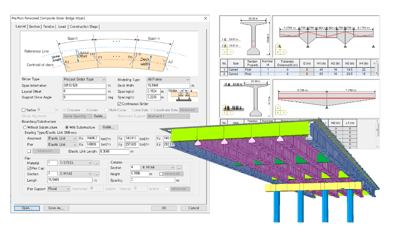
Modeling
+ Prestressed composite bridge wizard
+ Prestress loads (Tendon property/profile/prestress)
+ Change tendon profile
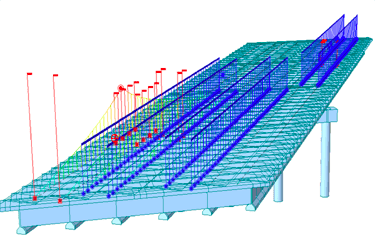
Analysis
+ Moving load analysis
+ Construction stage analysis
+ Load combination (Auto generation)
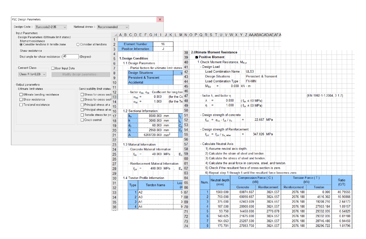
Design
+ PSC Design
In midas Civil, structural analysis and section review of precast concrete bridges can be performed simply and accurately. The prestressing force can be considered using the tendon profile, and design standards and function are provided to consider for both post-tensioning and pre-tensioning. Convenience options are available to minimize the task of optimizing the tendon profile and prestress. After structural analysis, load combinations can be generated with the auto-generation option and the capacity of section girders can be checked in the PSC design.
Details
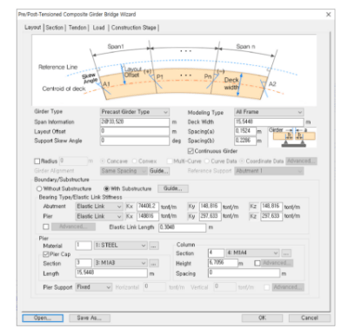
Prestressed Composite Bridge Wizard
The Prestressed Composite Bridge Wizard makes it easy to model precast girder bridges. Both straight and curved bridges are possible, and boundary conditions, dead loads, and moving loads are considered for the basic model required for structural analysis. Furthermore, the construction stage is considered simultaneously; therefore, the user can review the construction stage composition of Precast girder bridges.
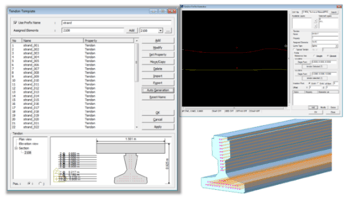
Tendon Property
The Tendon Property function allows the user to consider the tension method and the time-dependent properties of tendons. The Tendon Profile function can implement the shape of the tendon as coordinates, and accurate structural analysis can be performed by setting detailed options such as the transfer length and debonding length into the Tendon Profile function. In the Tendon Prestress function, jacking force (or jacking) can be considered, so the actual tensioning can be implemented accurately. Tendon optimization can be an iterative modeling process. For this inconvenience, the Change Tendon Profile function is provided.
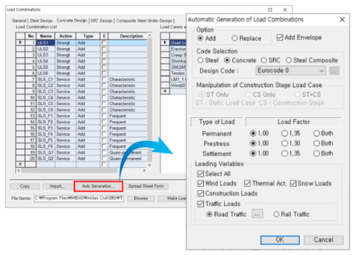
Load Combination ( Auto Generation)
In the Load Combination function, the user can combine several load cases used in structural analysis. Among the various options provided by the Load Combination function, the Auto Generation option creates load combinations that satisfy the desired design standards of the user.
Integral Bridges
Overview
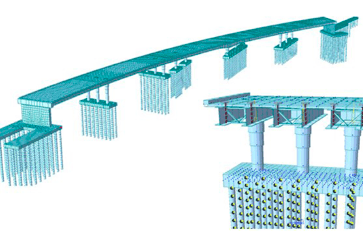
Modeling
+ Integral bridge function
+ Thermal loads (Element temp. & Temp. Gradient)
+ Hydrostatic pressure load
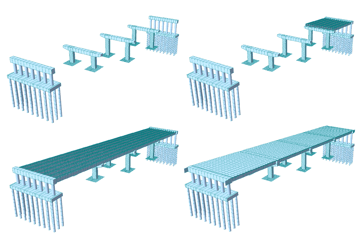
Analysis
+ Construction stage analysis
Design
+ Composite design for steel composite section
+ PSC design
+ RC design
In the structural analysis of Integral bridges, boundary conditions should be established according to the soil stiffness. Furthermore, in terms of the structure, the secondary effects of temperature/creep & shrinkage on the superstructure itself need to be calculated. Integral bridges can be modeled without limitations by using the various elements and spring supports provided in midas Civil. Additionally, temperature loads, time-dependent materials, and construction stage analysis functions can be used to complete the structural analysis of integral bridges, and the design function can be used to review the section of structures.
Details
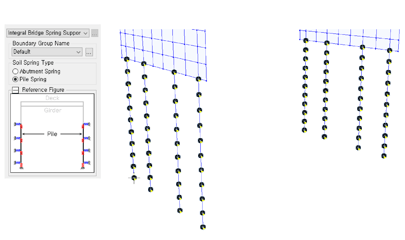
Integral Bridge Function
An alternative way to apply earth pressure loads is to assign appropriate spring supports to the abutment and/or piles to represent the soil properties. midas Civil provides an automatic generative function for the calculation of the spring stiffness for abutments and piles. The calculation method is based on the formulation proposed by B.M. Lehane.
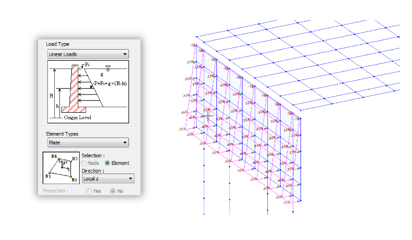
Hydrostatic Pressure Load Function
The Hydrostatic pressure load function can be applied to plates, plane stress, plane strain, or solid elements. Originally, it is a function that inputs pressure loads due to the flue potential, but it can be applied to the earth pressure as it can be considered for not only linear shapes but also curved shapes.
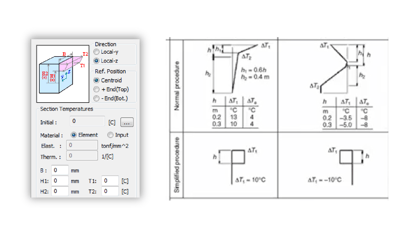
Element Temperature Load & Temperature
The thermal contraction/expansion of the deck influences the earth’s pressure. It is one of the design conditions for the abutment wall. midas Civil provides element temperature loads, temperature gradient loads, etc, to consider all thermal load types.
Culverts
Overview
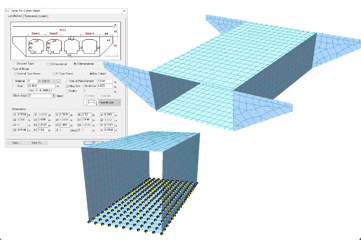
Modeling
+ RC frame/Box wizard
+ Surface spring
+ Define domain & Define sub-domain
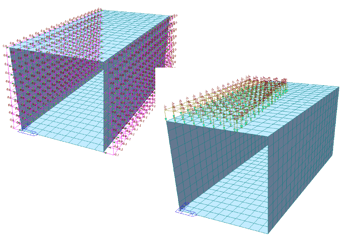
Analysis
+ Static analysis
+ Moving load analysis
+ Boundary change assignment to load case/Analysis
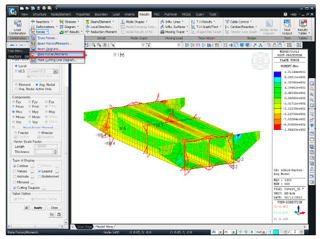
Design
+ RC design
+ Local direction force sum
+ Resultant force diagram
A Box culvert is usually a default buried structure that serves a variety of purposes. In midas Civil, box culverts can be modeled using various element types, boundary conditions, and load types. Furthermore, it is possible to review the appropriate section using the RC design function under the Design function, so that the design of a box culvert can be completed in one single program.
Details
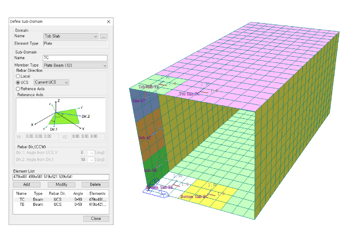
Define Domain & Define Sub-Domain
Domain and sub-domain settings are required to perform design for plate elements in midas Civil. After setting up to the sub-domain, Plate Beam or Plate Column Design of the RC design function and the checking function can be used.
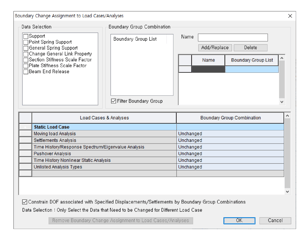
Boundary Change Assignment to Load Case/Analysis
Different load (Analysis) cases can retain separate boundary conditions within a model. Even in the case where static analysis and dynamic analysis are associated with different boundary conditions, the two analyses can be carried out within the same model instead of two different model files.
RC Design
In the RC Design function, the user can perform section reviews according to country-specific design standards. Furthermore, inputs required for design can be easily entered. The RC Design function is divided into Design and Checking. The Design function uses analysis results and design inputs to design each member and provides the optimal amount of reinforcement needed for the structure. The Checking function performs component-specific design using analysis results and design inputs and reviews the appropriate design conditions.
Other Structures
Overview
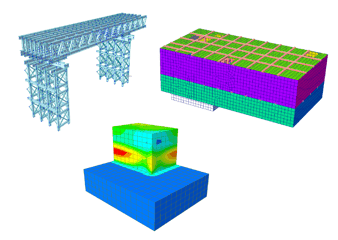
Step 1
+ Various elements (Truss, Beam, Plate, and Solid)
+ Various structure wizards
+ Various boundary types
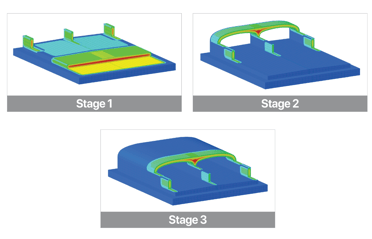
Step 2
+ Static loads (Various types)
+ Heat of hydration load types
+ Construction stage analysis
Step 3
+ Structure type
+ Heat of hydration analysis control
+ General section designer (GSD)
In midas Civil, modeling is possible using various elements. Furthermore, various Static load types and Boundary types are available. Therefore, it is possible to perform structural analysis and modeling not only for bridge structures but also for various other types of structures. For example, 3D solid elements and Heat of Hydration Load types can be used to perform hydration heat analysis of concrete, and structural analysis can be performed by directly modeling the temporary equipment.
Details
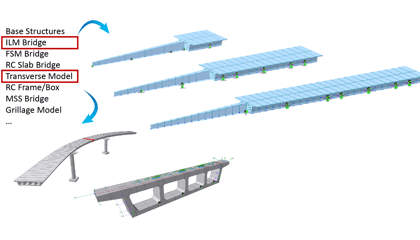
Various Structure Wizards
midas Civil offers a variety of wizards for structures that are frequently modeled by engineers. Through the wizard, users can quickly solve repetitive modeling tasks or define many construction stages. Furthermore, the wizard is provided based on the construction method or the shape of the structure. e.g.)Construction method (ILM Bridge Wizard, FCM Bridge Wizards, MSS Bridge Wizard, and FSM Bridge Wizard), Structure type (Suspension Bridge Wizard, Cable-Stayed Bridge Wizard, RC Slab Bridge Wizard, RC Frame/Box Wizard, Grillage Model Wizard, and Transverse Model Wizard).
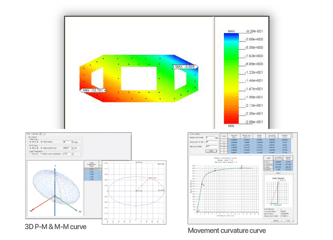
General Section Designer (GSD)
General Section Designer is a tool that calculates the section properties, interaction curves, moment curvatures, and stress distributions of the general shape of sections.
Heat of Hydration Load & Analysis
The heat of hydration analysis of massive concrete structures can be performed using the solid element and construction stage analysis functions in midas Civil. Furthermore, ambient temperature analysis and stress analysis can be performed using the functions provided.
Cable Stayed Bridges
Overview
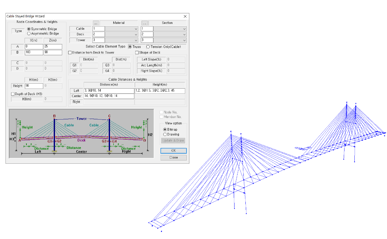
Modeling
+ Cable-stayed bridge wizard
+ Import *.dxf
+ Various element types & boundary types
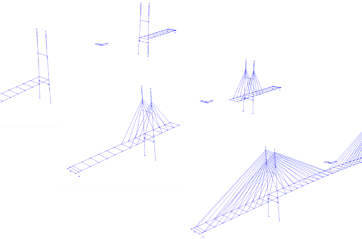
Analysis
+ Static analysis
+ Construction stage analysis
+ Dynamic analysis
Design
+ Unknown load factor
+ Cable force tuning
The structural analysis of cable-stayed bridges in midas Civil is as follows. Firstly, after completing the model with the wizard or modeling function, enter the dead load into the model. Thereafter, calculate the initial tension of the cable with the Unknown Load Factor function. When the initial shape is determined, the structural analysis can be completed by performing the construction stage analysis, the moving load analysis, the dynamic analysis (including seismic analysis), and the eigenvalue buckling analysis provided by midas Civil.
Details
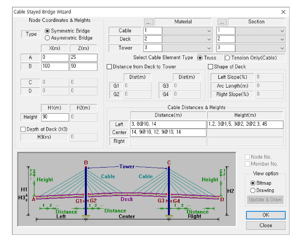
Cable Stayed Bridge Wizard
The Cable Stayed Bridge Wizard is a function that is available for user modeling convenience. With this function, the user can create a 2D model considering the symmetrical and asymmetrical shape of cable-stayed bridges, the shape of girders (trusses or beams), and the elevation of bridges.
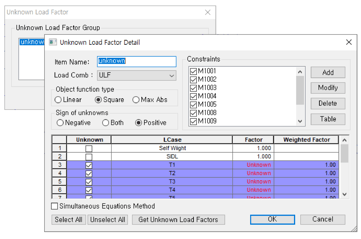
Unknown Load Factor
The Unknown Load Factor is an optimization function for determining the optimal load factor that satisfies specific constraints of structures. It can be used effectively to calculate the initial tension introduced into cables of cable-stayed bridges or to obtain jack-up loads for adjusting the moment distribution of long-span bridges.
Cable force tuning
Several repetitive calculations are required in order to calculate the optimum cable tension in a cable-stayed bridge. However, the Cable Force Tuning function is used to shorten this repetitive calculation process by calculating the displacement/member force/stress effects on the cable tension (or load factor) adjusted by the user using the influence matrix. The outputs or results are then shown in a real-time graph.
Balanced Cantilever Bridges
Overview
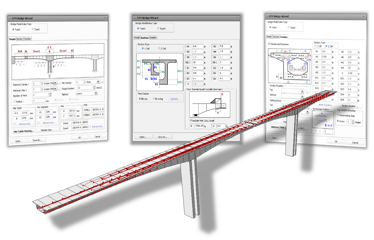
Modeling
+ FCM wizard
+ Prestress loads (Tendon property/Profile/Prestress)
+ Time-dependent materials
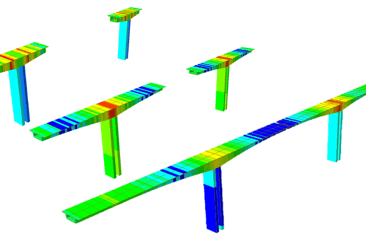
Analysis
+ Construction stage analysis control
+ Moving load analysis
+ Seismic analysis
Design
+ FCM camber control
+ FCM camber table
+ PSC design
midas Civil provides functions tailored to the modeling, analysis, and design stages of balanced cantilever bridges. Users can freely create bridge element models. midas Civil defines tendon profiles directly for the prestress force. It allows accurate prestress forces to be applied to the structure. Furthermore, the completed model and the construction stage model can be implemented in one model file, considering the influence of time-dependent materials.
Details
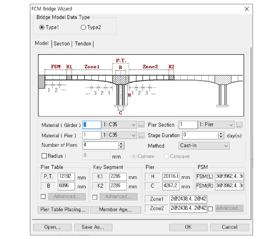
FCM Wizard
The FCM Wizard creates an analytical model by considering the bridge model, loads, and construction stage plans. The FCM Wizard provides a simple and clear input box that allows users to easily create and review bridge models. Furthermore, the FCM Wizard provides two analytical model methods to create balanced cantilever bridges of various shapes.
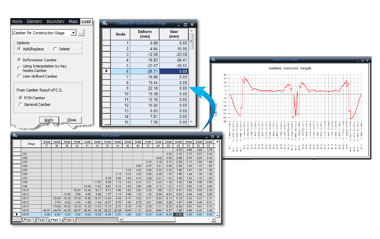
FCM Camber Control/Graph View/Table
midas Civil provides FCM Camber Control, FCM Graph View, and Table functions in order to clearly derive the results of the construction stage analysis of balanced cantilever bridges. The amount of camber is shown in tables and graphs throughout the entire construction stage.
PSC Design
midas Civil provides design optimization according to various design standards including AASHTO, Eurocode, BS code, IRC, and AS code. Structural design (structural analysis to section design) can be quickly performed in one model file. Furthermore, design is performed separately from structural analysis, enabling rapid design optimization.
Suspension Bridges
Overview
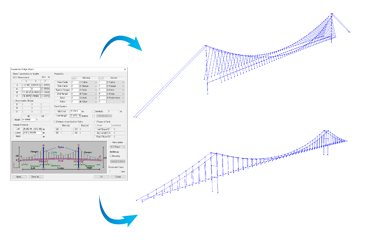
Modeling
+ Various elements (Truss, Cable, Beam and etc.)
+ Suspension bridge wizard
+ Section property calculator
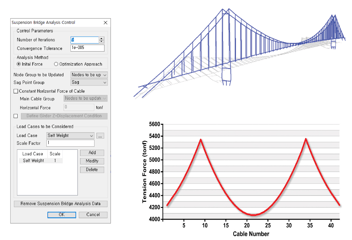
Analysis
+ Beam end release
Design
+ Suspension bridge analysis control
+ Construction analysis control
+ Stage/Step history graph
The structural analysis of a suspension bridge is divided into completed state analysis and construction stage analysis. The completed state analysis is performed by checking the behavior of the completed bridge. The construction stage analysis is performed by checking the structural stability and calculated section forces during erection. midas Civil provides various functions to perform a complete analysis of suspension bridges.
Details
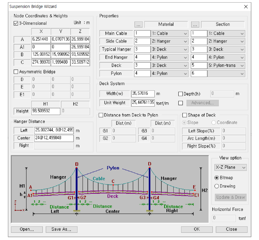
Suspension Bridge Wizard
The Suspension Bridge Wizard function automatically generates 2D or 3D suspension bridge models while calculating the undeformed lengths of cables and hangers at the same time. Upon finalizing the model, the final undeformed lengths, the geometric shape, and the internal member stresses are calculated using the function in the Suspension Bridge Wizard Control.
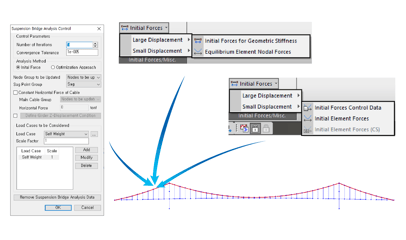
Suspension Bridge Analysis Control
The suspension bridge model needs to be analyzed in order to determine the accurate initial configuration of the global system of a bridge. Two options are provided for the analysis. The Initial Force method determines an initial configuration of a suspension bridge model by updating initial forces. The Optimal Approach method determines an initial configuration of a suspension bridge model by updating design parameters that satisfy the specified constraint condition.
Construction Stage Analysis Control
The effect of large displacements can’t be ignored when calculating forces for the erection of suspension bridges. Nonlinear construction stage analysis is carried out while reflecting the equilibrium element nodal forces calculated in the completed state analysis. Construction Stage Analysis Control provides several options for large displacement analysis, geometry nonlinear, and cable force analysis.
Moving Load Analysis
Overview
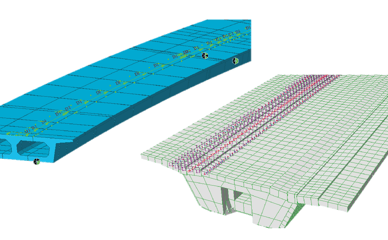
Step 1
+ Traffic line lanes
+ Traffic surface lanes
+ Moving load optimization
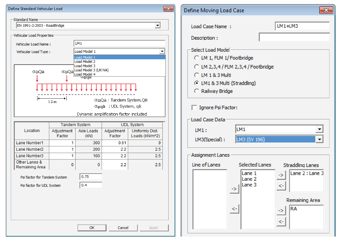
Step 2
+ Vehicles
+ Moving load cases
Step 3
+ Influence line/Surface
+ Moving load tracer
The moving load analysis function in midas Civil is used to statically analyze and design bridge structures for vehicle moving loads. Important features are included as follows:
Generation of influence line and influence surface for displacements, member forces, and reactions due to moving loads. Calculation of maximum/minimum nodal displacements, member forces, and support reactions for a given moving vehicle load using generated influence line and influence surface.
Details
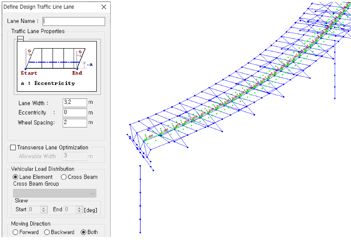
Traffic Line/Surface Lanes
The moving load analysis in midas Civil is effectively performed based on the influence line/surface analysis. To do this, create a traffic line lane or traffic surface lane. It is possible to define traffic lanes for various shapes of elements. Furthermore, by providing options to respond to country-specific design standards and structure types, it is possible to define traffic lanes according to the intention of the engineer. In particular, the optimization function allows the program to automatically consider the location of more moving loads without defining additional traffic lanes.
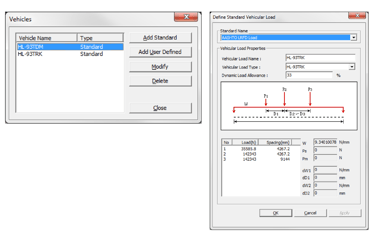
Vehicles & Moving Load Cases
midas Civil provides vehicle load models for each country-specific design code. Furthermore, user-defined functions are also provided to cope with various design environments. In the moving load case function, the user can define moving load cases that meet the country’s design standards by combining traffic lanes and vehicles.
Moving Load Tracer
When moving load analysis is completed, the user can check the envelop results of the analysis, such as the maximum/minimum member force/displacement. The moving load tracer function shows the distribution of the vehicle moving load that represents critical results of the analysis with influence line/surface diagrams. Furthermore, this function selects a specific moving load and converts it to a static load so that it can be used as a load for further analysis.
Construction Stage Analysis
Overview
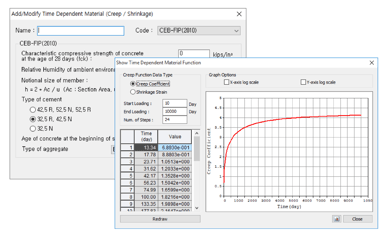
Step 1
+ Time-Dependent materials
+ Groups for structures/boundaries/loads
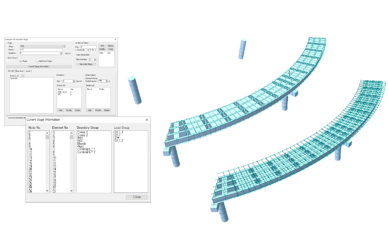
Step 2
+ Define the construction stage
+ Composite section for construction stage
Step 3
+ Construction stage analysis control data
+ Results along construction stages
Dynamic Analysis
Overview
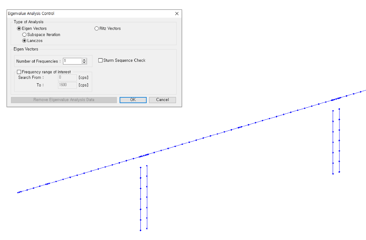
Step 1
+ Eigenvalue analysis control
+ Nodal masses/Loads to masses
+ Rail track interaction analysis wizard
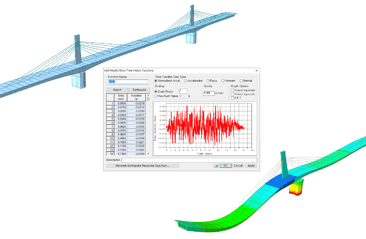
Step 2
+ Response spectrum analysis
+ Time history analysis
+ Dynamic analysis for railway bridge
Step 3
+ Mode shapes/Modal damping ratio
+ Time history results
Through midas Civil, the user can perform dynamic analysis of structures such as seismic design, rail-structure interaction, and dynamic behavior of pedestrian bridges. In order to perform dynamic analysis, midas Civil provides eigenvalue analysis, response spectrum analysis, and time history analysis. Furthermore, midas Civil’s Boundary Change Assignment function enables static analysis and dynamic analysis in one model file.
Details
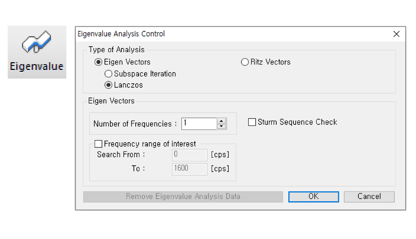
Eigenvalue Analysis Control
In midas Civil, the user can consider time-dependent characteristics of concrete such as Creep, Shrinkage, and Aging. Furthermore, the user can also consider the time-dependent characteristics of steel such as relaxation. All time-dependent characteristics are based on the design code, and user-defined options are also provided to consider various design conditions.
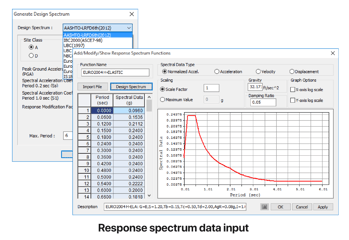
Response Spectrum Functions & Load Cases
In midas Civil, it is possible to analyze the response spectrum for the Z direction and the X-Y plane direction of the global coordinate system. For the modal combination, the user can use the Complete Quadratic Combination (CQC) method and the Square Root of the Sum of the Squares (SRSS) method depending on the user’s choice. Design spectrum and earthquake data for seismic design are provided by region and design codes.
Time History Load Cases & Time Forcing Functions
midas Civil provides a modal superposition method and direct integration for time history analysis. The Time forcing function allows users to consider dynamic loads such as ground acceleration, dynamic nodal loads, and time-varying static loads in order to perform various different analyses. Furthermore, it also allows users to consider time-variable static loads for various analyses.
Nonlinear Analysis
Overview
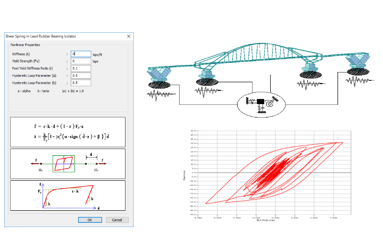
Step 1
+ Nonlinear elements & elastic links
+ General link properties (Boundary Nonlinear)
+ Seismic device properties
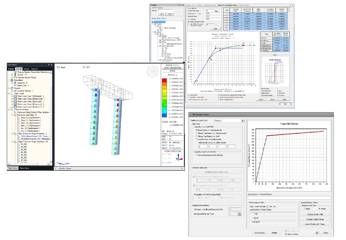
Step 2
+ Pushover analysis
+ Plastic material
+ Nonlinear analysis control
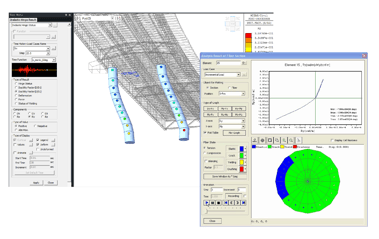
Step 3
+ Inelastic hinge properties
+ Moment curvature
+ Inelastic material
Nonlinear analysis is necessary when stresses are excessive or large displacements exist in structures. Construction stage analyses for suspension bridges and cable-stayed bridges are some examples of large displacement in structures. midas Civil provides various functions that allow engineers to consider the material’s nonlinear behavior, geometric nonlinearity, and boundary nonlinearity of the analytical model.
Details
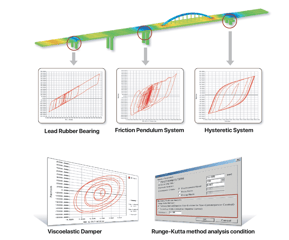
General Link Properties
General Link elements are used for modeling damping devices, base isolators, compression-only or tension-only elements, plastic hinges, soil springs, etc. General Link elements can be assigned to linear and nonlinear properties using spring properties.
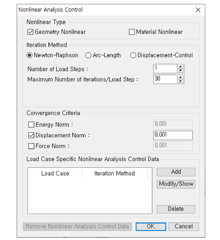
Nonlinear Analysis Control
Users can quickly apply settings for nonlinear analysis in the Nonlinear Analysis Control function. Iteration methods for nonlinear analysis are provided with Newton-Raphson, arc-length, and displacement control. Three different methods (Energy Norm, Displacement Norm, and Force Norm) are provided to adjust the convergence of analyses.
Pushover Analysis
midas Civil provides pushover analysis to support a performance-based design. The Pushover Global Control function provides detailed options for analysis. After completing the analysis, the user can review the analysis results in tables, graphs, texts, etc.
Rail-Structure Interaction
Overview
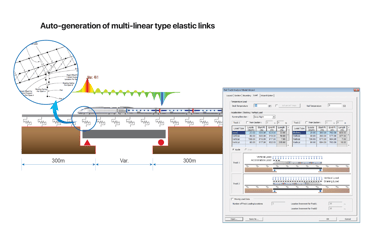
Step 1
+ Rail track analysis model wizard
+ Static loads & Link boundaries
+ Train load generator
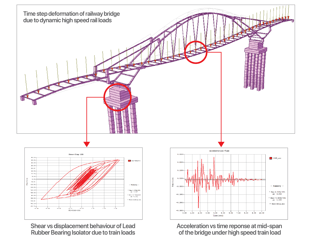
Step 2
+ Static analysis
+ Time history analysis
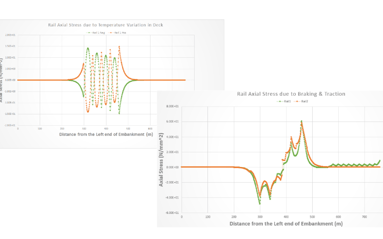
Step 3
+ Rail track analysis report
+ Time history results/graph
In midas Civil, two methods of rail-structure interaction analysis are proposed. The first one is a static analysis and the other is a time history analysis that checks dynamic responses. In static analysis, the user can check the results after manual modeling. In particular, Rail Track Analysis Model & Report Wizard are provided to solve the hard work and inaccuracies of modeling continuously welded rails. Furthermore, they provide descriptions and functions of load and boundary conditions for RSI analysis.
Details
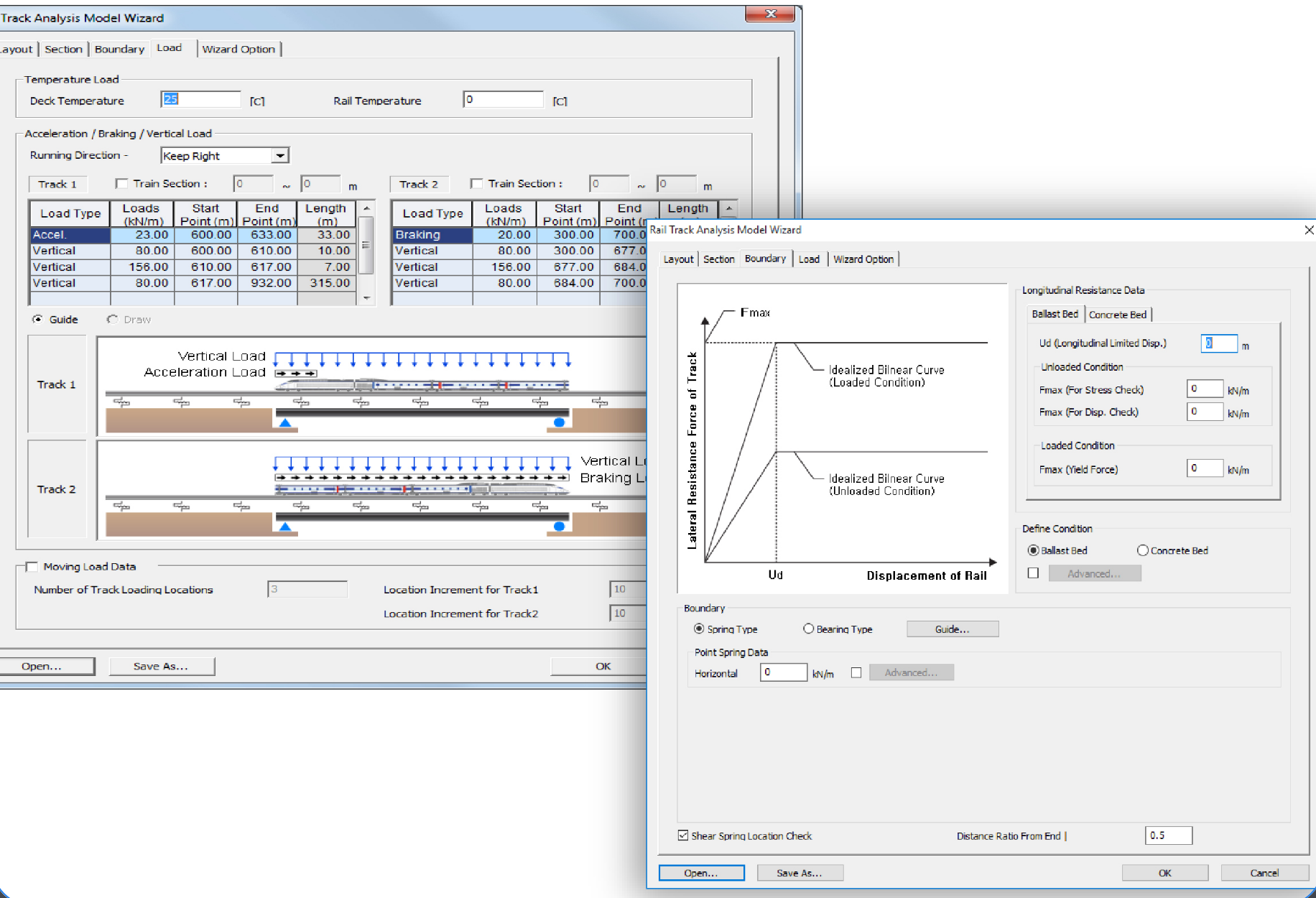
Rail Track Analysis Model Wizard
Rail Track Analysis Model Wizard receives simple input values for rail, bridge structure, and embankment models, and automatically creates an analytical model that includes sections, boundary conditions, and loads. The wizard provides three modeling options:
– Automatic modeling for simplified separate analysis
– Automatic modeling for moving load analysis
– Automatic modeling for stage analysis
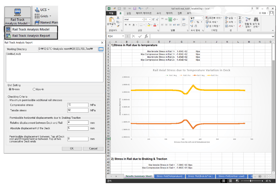
Rail Track Analysis Report Wizard
As a post-processing feature, Rail Track Analysis Report Wizard can be used to analyze all models and obtain compiled excel files. It provides a final summary sheet with checks based on UIC 774-3. These check limits are manually modified for regional codes. The report will contain tabulated data as well as graphical outputs for individual rail stresses, rail and deck relative displacements, and deck absolute displacements.
Train Load Generator
Generate time-forcing functions without considering the length of the element along the track. The required nodal spacing along the track is automatically detected by the program. The train load generator function also creates a time-force curve for train loads. Furthermore, the dynamic nodal load for time history analysis is automatically inputted using the time-force curve created in the node located in the designated track.
Soil-Structure Interaction
Overview
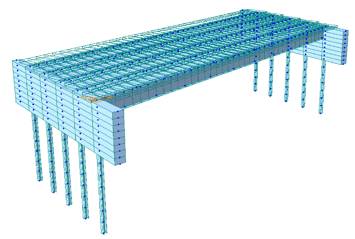
Model
+ Beam element
+ Plate element
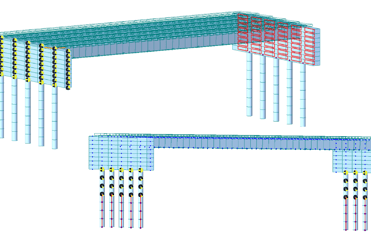
Boundaries & Loads
+ Point/Surface spring
+ Integral bridge
+ Inelastic hinge property
Analysis
+ Export *.mxf file (for FEA/GTS)
+ Import nodal results (for GTS)
+ Export nodal results (for GTS)
In midas Civil, various boundary types are provided so that soil-structure interaction can be applied according to the design condition. It also allows the user to be able to model a structure without having to worry about using beam and plate elements. Depending on the design condition, the stiffness can be used as a simple value, a stiffness matrix, or a p-y curve. Additionally, model files are mutually exchangeable with GTS NX, a geotechnical program of MIDAS IT, and the exact p-y curve applied to the spring support can be calculated.
Details
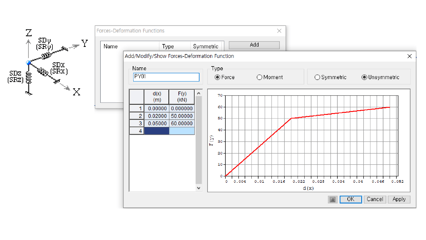
Point Spring
The user can apply spring stiffness to nodes using the Point Spring function. Linear, compression/tension-only, and multi-linear using user-defined force-displacement curves are used to define the spring stiffness. If the spring stiffness data is available, the user can consider spring supports by entering the stiffness value directly into the 6×6 stiffness matrix using the general spring function.
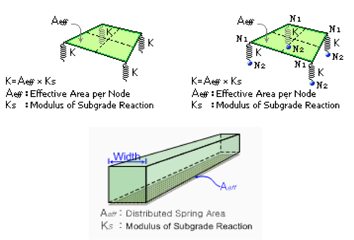
Surface Spring
The surface spring function applies spring stiffness per unit area or unit length to selected elements. Spring support can be considered for analysis purposes by providing two methods. A nodal spring method which distributes stiffness to nodes, and a distributed spring method distributes stiffness evenly to elements.
Interface with GTS NX
In order to derive a more accurate p-y curve of the soil, the user can collaborate with MIDAS IT’s geotechnical program GTS NX. After modeling the structure in midas Civil, the user can import the model into GTS NX. Furthermore, for the accurate Soil-Structure Interaction Analysis, analysis results such as displacement or reaction forces of nodes applied with spring supports can be exported from midas Civil to GTS NX. And the p-y curve of spring supports can be imported from GTS NX to midas Civil.
Related products
-
Sale!

DESIGN SUITE cracked version
$ 8,000.00Original price was: $ 8,000.00.$ 250.00Current price is: $ 250.00. Add to cart Quick View -
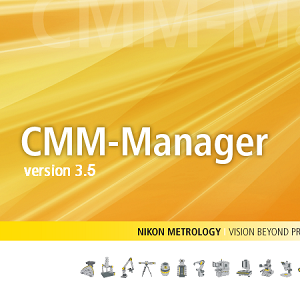
Nikon CMM-Manager 3.5 cracked
$ 180.00 Add to cart Quick View -
Sale!

DRAWings 8 Pro cracked version
$ 1,800.00Original price was: $ 1,800.00.$ 140.00Current price is: $ 140.00. Add to cart Quick View -
Sale!

Wilcom Embroidery Studio E3 Designing cracked with dongle emulator
$ 3,000.00Original price was: $ 3,000.00.$ 110.00Current price is: $ 110.00. Add to cart Quick View -
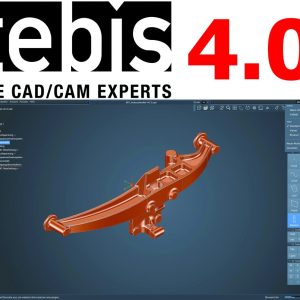
Tebis V4.0 R4 full cracked version
$ 160.00 Add to cart Quick View -
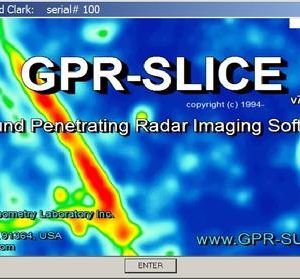
GPR-SLICE v7.0 cracked radar software
$ 160.00 Add to cart Quick View -
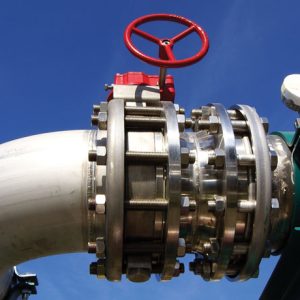
Intergraph PV Elite V21 cracked version
$ 140.00 Add to cart Quick View -

ETAP 14.1 cracked version download
$ 140.00 Add to cart Quick View -
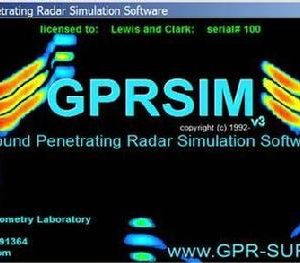
GPRSIM v3.0 cracked version
$ 130.00 Add to cart Quick View -
Sale!
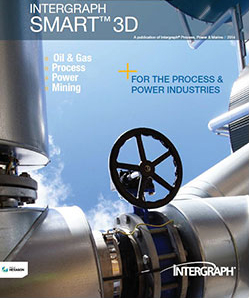
Intergraph Smart 3D 2016 cracked version
$ 180.00Original price was: $ 180.00.$ 135.00Current price is: $ 135.00. Add to cart Quick View


